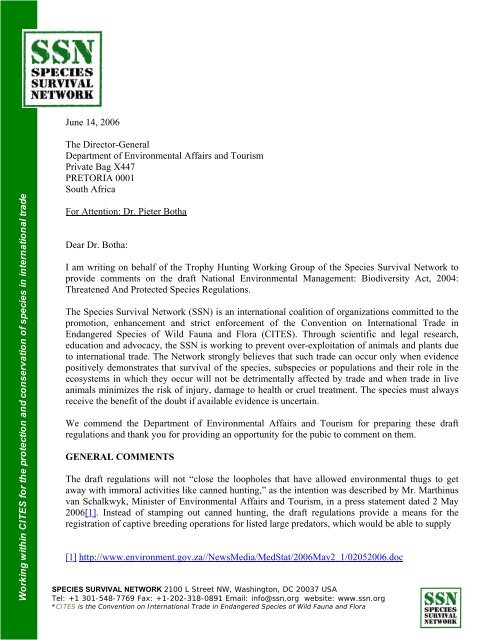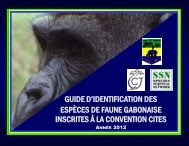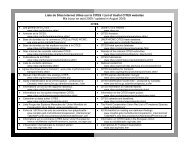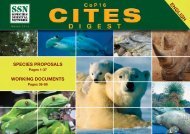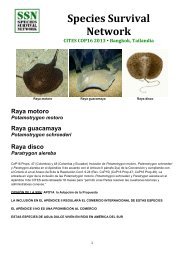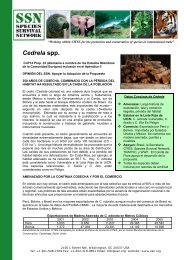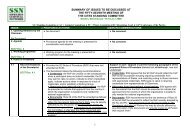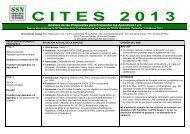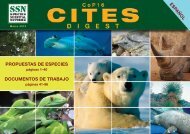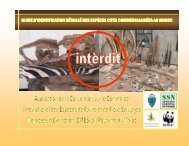SSN's Comments on South Africa's Regulations on Threatened and ...
SSN's Comments on South Africa's Regulations on Threatened and ...
SSN's Comments on South Africa's Regulations on Threatened and ...
Create successful ePaper yourself
Turn your PDF publications into a flip-book with our unique Google optimized e-Paper software.
June 14, 2006<br />
Working within CITES for the protecti<strong>on</strong> <strong>and</strong> c<strong>on</strong>servati<strong>on</strong> of species in internati<strong>on</strong>al trade<br />
The Director-General<br />
Department of Envir<strong>on</strong>mental Affairs <strong>and</strong> Tourism<br />
Private Bag X447<br />
PRETORIA 0001<br />
<strong>South</strong> Africa<br />
For Attenti<strong>on</strong>: Dr. Pieter Botha<br />
Dear Dr. Botha:<br />
I am writing <strong>on</strong> behalf of the Trophy Hunting Working Group of the Species Survival Network to<br />
provide comments <strong>on</strong> the draft Nati<strong>on</strong>al Envir<strong>on</strong>mental Management: Biodiversity Act, 2004:<br />
<strong>Threatened</strong> And Protected Species Regulati<strong>on</strong>s.<br />
The Species Survival Network (SSN) is an internati<strong>on</strong>al coaliti<strong>on</strong> of organizati<strong>on</strong>s committed to the<br />
promoti<strong>on</strong>, enhancement <strong>and</strong> strict enforcement of the C<strong>on</strong>venti<strong>on</strong> <strong>on</strong> Internati<strong>on</strong>al Trade in<br />
Endangered Species of Wild Fauna <strong>and</strong> Flora (CITES). Through scientific <strong>and</strong> legal research,<br />
educati<strong>on</strong> <strong>and</strong> advocacy, the SSN is working to prevent over-exploitati<strong>on</strong> of animals <strong>and</strong> plants due<br />
to internati<strong>on</strong>al trade. The Network str<strong>on</strong>gly believes that such trade can occur <strong>on</strong>ly when evidence<br />
positively dem<strong>on</strong>strates that survival of the species, subspecies or populati<strong>on</strong>s <strong>and</strong> their role in the<br />
ecosystems in which they occur will not be detrimentally affected by trade <strong>and</strong> when trade in live<br />
animals minimizes the risk of injury, damage to health or cruel treatment. The species must always<br />
receive the benefit of the doubt if available evidence is uncertain.<br />
We commend the Department of Envir<strong>on</strong>mental Affairs <strong>and</strong> Tourism for preparing these draft<br />
regulati<strong>on</strong>s <strong>and</strong> thank you for providing an opportunity for the pubic to comment <strong>on</strong> them.<br />
GENERAL COMMENTS<br />
The draft regulati<strong>on</strong>s will not “close the loopholes that have allowed envir<strong>on</strong>mental thugs to get<br />
away with immoral activities like canned hunting,” as the intenti<strong>on</strong> was described by Mr. Marthinus<br />
van Schalkwyk, Minister of Envir<strong>on</strong>mental Affairs <strong>and</strong> Tourism, in a press statement dated 2 May<br />
2006[1]. Instead of stamping out canned hunting, the draft regulati<strong>on</strong>s provide a means for the<br />
registrati<strong>on</strong> of captive breeding operati<strong>on</strong>s for listed large predators, which would be able to supply<br />
[1] http://www.envir<strong>on</strong>ment.gov.za//NewsMedia/MedStat/2006May2_1/02052006.doc<br />
SPECIES SURVIVAL NETWORK 2100 L Street NW, Washingt<strong>on</strong>, DC 20037 USA<br />
Tel: +1 301-548-7769 Fax: +1-202-318-0891 Email: info@ssn.org website: www.ssn.org<br />
*CITES is the C<strong>on</strong>venti<strong>on</strong> <strong>on</strong> Internati<strong>on</strong>al Trade in Endangered Species of Wild Fauna <strong>and</strong> Flora
<strong>and</strong> facilitate the canned hunt industry as it occurs <strong>on</strong> so-called extensive wildlife systems (which can<br />
be fenced <strong>and</strong> include human provisi<strong>on</strong> of food, water <strong>and</strong> medical care). Nothing in these regulati<strong>on</strong>s<br />
prevents the breeding, keeping <strong>and</strong> hunting of listed large predators, including captive-bred <strong>on</strong>es, <strong>on</strong><br />
fenced “extensive wildlife systems”. It is c<strong>on</strong>tradictory to claim that these regulati<strong>on</strong>s will ban canned<br />
hunting when the hunting of large carnivores within fenced areas is allowed.<br />
Minister van Schalkwyk also stated, "The days of captive breeding of listed species for any purposes<br />
except science <strong>and</strong> c<strong>on</strong>servati<strong>on</strong>, are over.” However, the draft regulati<strong>on</strong>s allow listed large predators<br />
to be funneled from captive-breeding operati<strong>on</strong>s, rehabilitati<strong>on</strong> facilities, <strong>and</strong> even sanctuaries into<br />
“extensive wildlife systems” where they will be “rehabilitated” <strong>and</strong> can be hunted two years later.<br />
While this implies that these animals have returned to a wild state <strong>and</strong> are fair game for hunting, this is<br />
not the case. Although the period has been extended from six m<strong>on</strong>ths in the earlier draft to two years in<br />
this draft it is doubtful such reversi<strong>on</strong> is possible at all <strong>and</strong> will depend <strong>on</strong> a wide array of factors,<br />
including the species involved, the length of time in captivity <strong>and</strong> the nature of the captive c<strong>on</strong>diti<strong>on</strong>s<br />
under which the animal was maintained. Two years will not restore these instincts to a point where the<br />
hunting of them could c<strong>on</strong>stitute “fair chase”. It is c<strong>on</strong>tradictory to claim that captive breeding of<br />
threatened <strong>and</strong> protected species for anything except science <strong>and</strong> c<strong>on</strong>servati<strong>on</strong> will be banned when<br />
nothing in the draft regulati<strong>on</strong>s prevents the breeding, keeping <strong>and</strong> hunting of listed large predators,<br />
including <strong>on</strong>es bred elsewhere, <strong>on</strong> fenced “extensive wildlife systems”.<br />
The stated intenti<strong>on</strong> of these regulati<strong>on</strong>s is to “close the loopholes that have allowed envir<strong>on</strong>mental<br />
thugs to get away with immoral activities like canned hunting” <strong>and</strong> to end the “days of captive breeding<br />
of listed species for any purposes except science <strong>and</strong> c<strong>on</strong>servati<strong>on</strong>”. Yet, the majority of these<br />
regulati<strong>on</strong>s address <strong>on</strong>ly six species of listed large predators. We fail to see any reas<strong>on</strong> to restrict the<br />
vast majority of these draft regulati<strong>on</strong>s to listed large predators <strong>on</strong>ly. There are no ethical or<br />
c<strong>on</strong>servati<strong>on</strong>-based reas<strong>on</strong>s for having specific rules about the hunting of listed large predators that do<br />
not apply equally to other threatened <strong>and</strong> protected species. The captive breeding <strong>and</strong> canned hunting<br />
of all the other hundreds of listed threatened or protected species, will not be subject to these<br />
regulati<strong>on</strong>s. The regulati<strong>on</strong>s need to be exp<strong>and</strong>ed to address captive breeding <strong>and</strong> canned hunting of all<br />
threatened <strong>and</strong> protected species.<br />
The draft regulati<strong>on</strong>s often revert to province-level legislati<strong>on</strong> instead of establishing “… uniform<br />
nati<strong>on</strong>al systems that will apply the same st<strong>and</strong>ards throughout the country,” as stated by Minister van<br />
Schalkwyk. C<strong>on</strong>trol needs to come from nati<strong>on</strong>al level to enable uniformity of regulati<strong>on</strong> <strong>and</strong><br />
enforcement.<br />
Finally, the draft regulati<strong>on</strong>s c<strong>on</strong>tain numerous terms that are not fully defined <strong>and</strong> are open to broad<br />
interpretati<strong>on</strong>.<br />
SPECIFIC COMMENTS<br />
Chapter 1. Interpretati<strong>on</strong> <strong>and</strong> purpose of regulati<strong>on</strong>s<br />
Part 1. Definiti<strong>on</strong>s<br />
Definiti<strong>on</strong>: Bred in captivity/ captive bred<br />
This is defined as a “specimen bred in c<strong>on</strong>trolled envir<strong>on</strong>ment”. This definiti<strong>on</strong> is unclear <strong>and</strong><br />
2
inc<strong>on</strong>sistent with the definiti<strong>on</strong> of the same term in Resoluti<strong>on</strong> C<strong>on</strong>f. 10.16 (Rev.) of the C<strong>on</strong>venti<strong>on</strong> <strong>on</strong><br />
Internati<strong>on</strong>al Trade in Endangered Species of Wild Fauna <strong>and</strong> Flora (CITES).[1] C<strong>on</strong>sidering that<br />
specimens covered by these draft regulati<strong>on</strong>s are likely to be CITES-listed species (such as li<strong>on</strong>s <strong>and</strong><br />
leopards), <strong>and</strong> that CITES is implemented in <strong>South</strong> Africa in part through these regulati<strong>on</strong>s, it is<br />
imperative that the definiti<strong>on</strong> is identical to the CITES definiti<strong>on</strong> of “bred in captivity”. The draft<br />
definiti<strong>on</strong> is also unclear because, firstly, the term ‘bred’ as used in the definiti<strong>on</strong> seems to imply the<br />
birth of the animal rather than the breeding process; the former is inc<strong>on</strong>sistent with the CITES<br />
definiti<strong>on</strong>. Sec<strong>on</strong>dly, combining this definiti<strong>on</strong> with the related draft definiti<strong>on</strong>s of “c<strong>on</strong>trolled<br />
envir<strong>on</strong>ment” <strong>and</strong> “extensive wildlife system” leaves open the possibility of animals being bred in a<br />
captive setting <strong>on</strong> an extensive wildlife system, where they may also be hunted. As noted below, the<br />
draft definiti<strong>on</strong>s of “c<strong>on</strong>trolled envir<strong>on</strong>ment” <strong>and</strong> “extensive wildlife system” significantly overlap.<br />
Both terms allow for food, water, health care <strong>and</strong> fences. Yet, animals bred <strong>and</strong> born in captivity in an<br />
“extensive wildlife system” would not be c<strong>on</strong>sidered “captive bred” under these definiti<strong>on</strong>s. Nor would<br />
such systems be c<strong>on</strong>sidered to be “captive breeding operati<strong>on</strong>s” under the draft definiti<strong>on</strong> of that term.<br />
Definiti<strong>on</strong>: Captive-breeding operati<strong>on</strong><br />
This definiti<strong>on</strong> applies <strong>on</strong>ly to animals bred in a c<strong>on</strong>trolled envir<strong>on</strong>ment. It does not apply to animals<br />
bred in an extensive wildlife system. If this definiti<strong>on</strong> is to remain as drafted, the terms “c<strong>on</strong>trolled<br />
envir<strong>on</strong>ment” <strong>and</strong> “extensive wildlife system” need to be further distinguished from <strong>on</strong>e another.<br />
Otherwise, this definiti<strong>on</strong> will open up a loophole for the c<strong>on</strong>tinuati<strong>on</strong> of breeding animals for canned<br />
hunting in extensive wildlife systems.<br />
Definiti<strong>on</strong>: C<strong>on</strong>trolled envir<strong>on</strong>ment<br />
This definiti<strong>on</strong> is not c<strong>on</strong>sistent with the definiti<strong>on</strong> of the same term in CITES Resoluti<strong>on</strong> C<strong>on</strong>f. 10.16<br />
(Rev.).[2] C<strong>on</strong>sidering that specimens covered by these draft regulati<strong>on</strong>s are likely to be CITES-listed<br />
species (such as li<strong>on</strong>s), <strong>and</strong> that CITES is implemented in <strong>South</strong> Africa in part through these<br />
regulati<strong>on</strong>s, it is imperative that the definiti<strong>on</strong> is identical to the CITES definiti<strong>on</strong> of “bred in<br />
captivity”. As noted above, the draft definiti<strong>on</strong>s of the key terms “c<strong>on</strong>trolled envir<strong>on</strong>ment” <strong>and</strong><br />
“extensive wildlife system” significantly overlap <strong>and</strong> are indistinguishable. Both terms allow for food,<br />
water health care <strong>and</strong> fences. These are key definiti<strong>on</strong>s because wildlife can be c<strong>on</strong>sidered “bred in<br />
captivity” or “captive bred” <strong>on</strong>ly when produced in a “c<strong>on</strong>trolled envir<strong>on</strong>ment”, not an “extensive<br />
wildlife system”.<br />
Definiti<strong>on</strong>: Culling<br />
Definiti<strong>on</strong>s (a) <strong>and</strong> (b) of “culling” allows for a “pers<strong>on</strong> designated by” an official of the management<br />
authority of a protected area to kill animals. We recommend clarificati<strong>on</strong> that such a pers<strong>on</strong> should be a<br />
professi<strong>on</strong>al (not an amateur) marksman with dem<strong>on</strong>strated experience <strong>and</strong> skill in killing the species<br />
in questi<strong>on</strong>. Definiti<strong>on</strong> (b) states that animals that have escaped from a protected area may be killed “as<br />
a matter of last resort”. We recommend this term be clarified by adding the following words: “… as a<br />
matter of last resort after all other opti<strong>on</strong>s have been carefully evaluated.” We also recommend that this<br />
language be included in definiti<strong>on</strong> (a).<br />
Definiti<strong>on</strong>: Damage causing animal<br />
The draft definiti<strong>on</strong> does not reflect the fact that assessment of damage is largely subjective; threshold<br />
estimates of damage should be required before an animal is c<strong>on</strong>sidered to be damage-causing <strong>and</strong><br />
becomes a target. In additi<strong>on</strong>, it must be recognized that while individual animals may cause damage,<br />
this does not mean that the species as a whole should be c<strong>on</strong>sidered ‘damage causing’. We recommend<br />
3
that the clause ‘means a listed animal that…’ be changed to ‘means an individual of a listed animal that<br />
has been dem<strong>on</strong>strated to be the cause of the alleged unreas<strong>on</strong>able damage’.<br />
Definiti<strong>on</strong>: Extensive wildlife system<br />
As noted above, the draft definiti<strong>on</strong>s of the key terms “c<strong>on</strong>trolled envir<strong>on</strong>ment” <strong>and</strong> “extensive wildlife<br />
system” significantly overlap <strong>and</strong> are indistinguishable. Both terms allow for food, water health care<br />
<strong>and</strong> fences. The definiti<strong>on</strong> of “c<strong>on</strong>trolled envir<strong>on</strong>ment” includes a means of enclosure to prevent the<br />
animals from escaping. While the definiti<strong>on</strong> of “extensive wildlife system” does not state whether or<br />
not there can be any sort of enclosure or attempt to keep the animals in the system, the definiti<strong>on</strong> of<br />
“c<strong>on</strong>trolled envir<strong>on</strong>ment” states that extensive wildlife systems can include fences. Although the<br />
definiti<strong>on</strong>s of these terms significantly overlap, animals bred <strong>and</strong> born in captivity in an “extensive<br />
wildlife system” would not be c<strong>on</strong>sidered “captive bred” under these definiti<strong>on</strong>s. These are key<br />
definiti<strong>on</strong>s because wildlife can be c<strong>on</strong>sidered “bred in captivity” <strong>on</strong>ly when produced in a “c<strong>on</strong>trolled<br />
envir<strong>on</strong>ment”, not an “extensive wildlife system”. This means that animals born into a captive setting<br />
in an extensive wildlife system can be hunted there or elsewhere. The intenti<strong>on</strong> seems to be to<br />
distinguish the terms based <strong>on</strong> the level of human interventi<strong>on</strong> (provisi<strong>on</strong> of food, etc.), the size of the<br />
l<strong>and</strong> involved, <strong>and</strong> the ability of the wildlife populati<strong>on</strong> to be “self-sustaining”. Yet, in practice, there<br />
would be a sliding scale of such operati<strong>on</strong>s <strong>and</strong> it would be difficult to judge where to draw the line<br />
based <strong>on</strong> these definiti<strong>on</strong>s. More importantly, if the objectives are to eliminate hunting of captive-bred<br />
animals <strong>and</strong> canned hunting, the draft should be revised to explicitly prohibit the hunting of animals<br />
captive-bred or c<strong>on</strong>fined within any enclosure. It is c<strong>on</strong>tradictory to claim that the desired effect is to<br />
ban canned hunting when the draft regulati<strong>on</strong>s allow the hunting of large carnivores within fenced<br />
areas. It is also c<strong>on</strong>tradictory to claim that large carnivores will not be captive bred for hunting when<br />
the draft regulati<strong>on</strong>s allow the hunting of animals bred in captivity, including <strong>on</strong> fenced extensive<br />
wildlife systems.<br />
Definiti<strong>on</strong>: Management plan<br />
The term “management plan” is not defined in secti<strong>on</strong> 1 of the Protected Areas Act as stated in the<br />
draft.[3]<br />
Definiti<strong>on</strong>: Put <strong>and</strong> take animal<br />
This is defined as “a live specimen of a listed large predator species that is released <strong>on</strong> a property<br />
irrespective of the size of the property for the purpose of hunting the animal.” We recommend that this<br />
term not be c<strong>on</strong>fined <strong>on</strong>ly to “listed large predator species” but to all “listed species”. There are no<br />
sound ethical or c<strong>on</strong>servati<strong>on</strong>-based reas<strong>on</strong>s that any threatened or protected species should be subject<br />
to “put <strong>and</strong> take”.<br />
Definiti<strong>on</strong>: Rehabilitati<strong>on</strong> facility<br />
Three key terms—“rehabilitati<strong>on</strong> facility”, “sanctuary”, <strong>and</strong> “captive breeding operati<strong>on</strong>”—need to be<br />
further distinguished from <strong>on</strong>e another. We recommend adding language to the definiti<strong>on</strong> of<br />
“rehabilitati<strong>on</strong> facility” that prohibits captive breeding, in order to distinguish such facilities from<br />
captive breeding operati<strong>on</strong>s. We further recommend adding language to the definiti<strong>on</strong> of “rehabilitati<strong>on</strong><br />
facility” that prohibits the l<strong>on</strong>g-term care of individuals at the facility, in order to distinguish such<br />
facilities from sanctuaries. Definiti<strong>on</strong> (b) allows keeping protected animals for “rearing purposes, in the<br />
case of young orphaned specimens”. We recommend clarifying this by adding the words, “… for<br />
release into the wild.” Otherwise, “rearing” could also mean “keeping” them permanently in captivity<br />
<strong>and</strong> providing life-time care, which should be the work of a sanctuary.<br />
4
Definiti<strong>on</strong>: Sanctuary<br />
As noted above, three key terms—“rehabilitati<strong>on</strong> facility”, “sanctuary”, <strong>and</strong> “captive breeding<br />
operati<strong>on</strong>”—need to be further distinguished from <strong>on</strong>e another. We recommend adding language to the<br />
definiti<strong>on</strong> of “sanctuary” that prohibits captive breeding, in order to further distinguish such facilities<br />
from captive breeding operati<strong>on</strong>s.<br />
Purpose of these regulati<strong>on</strong>s<br />
Clause 2 should include: “to ensure that CITES is regulated in a uniform way across the country.”<br />
Chapter 2. Permit system for listed threatened or protected species<br />
Part 2. Applicati<strong>on</strong>s for new permits<br />
Who may apply for new permits<br />
Clause 5(2)(a) allows a management authority of a protected area to apply for a st<strong>and</strong>ing permit to<br />
c<strong>on</strong>duct restricted activities involving listed threatened or protected species “necessary for their<br />
management”. We recommend against allowing hunting in protected areas, particularly of listed<br />
species. Clarificati<strong>on</strong> is needed <strong>on</strong> whether this would include hunting of “elderly”, “n<strong>on</strong>-breeding”, or<br />
“surplus” stock.<br />
Clause 5(2)(c) allows pers<strong>on</strong>s c<strong>on</strong>ducting a registered captive breeding operati<strong>on</strong> to apply “for a<br />
st<strong>and</strong>ing permit to c<strong>on</strong>duct restricted activities involving listed threatened or protected species kept or<br />
bred at that captive breeding operati<strong>on</strong> that are necessary for the purpose for which that captivebreeding<br />
operati<strong>on</strong> is registered”. Cross-referencing this sub-clause with clause 29(2) makes it clear<br />
that the regulati<strong>on</strong>s allow captive breeding operati<strong>on</strong>s to hunt, sell or export listed large predators for<br />
hunting purposes. We str<strong>on</strong>gly oppose clauses 5(2)(c) <strong>and</strong> 29(2).<br />
We recommend the additi<strong>on</strong> of a new clause stating, “A pers<strong>on</strong> c<strong>on</strong>victed of an offense in terms of<br />
regulati<strong>on</strong> 78 must not apply for or receive a permit.”<br />
Documents to be submitted with applicati<strong>on</strong> involving listed large predators<br />
Clauses 9 through 49 pertain exclusively to listed large predators. The stated intenti<strong>on</strong> of these<br />
regulati<strong>on</strong>s is to “close the loopholes that have allowed envir<strong>on</strong>mental thugs to get away with immoral<br />
activities like canned hunting” <strong>and</strong> to end the “days of captive breeding of listed species for any<br />
purposes except science <strong>and</strong> c<strong>on</strong>servati<strong>on</strong>”. Yet, the majority of these regulati<strong>on</strong>s address <strong>on</strong>ly six<br />
species of listed large predators. The captive breeding <strong>and</strong> canned hunting of all the other hundreds of<br />
listed threatened or protected species, will not be subject to these regulati<strong>on</strong>s. We fail to see any reas<strong>on</strong><br />
to restrict the vast majority of these draft regulati<strong>on</strong>s to listed large predators <strong>on</strong>ly. There are no ethical<br />
or c<strong>on</strong>servati<strong>on</strong>-based reas<strong>on</strong>s for having specific rules about the hunting of listed large predators that<br />
do not apply equally to other threatened <strong>and</strong> protected species. The regulati<strong>on</strong>s need to be exp<strong>and</strong>ed to<br />
address captive breeding <strong>and</strong> canned hunting of all threatened <strong>and</strong> protected species.<br />
Clause 9(1)(a)(i) states that a permit applicati<strong>on</strong> for the hunting of a listed large predator may not be<br />
c<strong>on</strong>sidered by the issuing authority unless the owner of the l<strong>and</strong> <strong>on</strong> which the animal is to be hunted<br />
provides <strong>and</strong> affidavit or other written proof indicating “the period for which the predator to be hunted<br />
has been <strong>on</strong> that property, if that predator was not born <strong>on</strong> that property.” First, clarificati<strong>on</strong> is needed<br />
<strong>on</strong> what other form of “written proof” would be acceptable. Sec<strong>on</strong>d, the clause should make it clear<br />
5
that in the likely event that a l<strong>and</strong> owner states in an affidavit that he is uncertain of how l<strong>on</strong>g the<br />
animal has been <strong>on</strong> the property <strong>and</strong> does not know if the animal was born <strong>on</strong> the property, then an<br />
applicati<strong>on</strong> should not be c<strong>on</strong>sidered.<br />
Clause 9(1)(b), (c) <strong>and</strong> (d) state that breeders <strong>and</strong> people who sell, supply, <strong>and</strong> export the animal must<br />
provide a “written undertaking” (for breeders) or an “affidavit or other written proof” (for sellers,<br />
suppliers, exporters, purchasers, or those who acquire) that the predator will not be bred (in the case of<br />
breeders), “sold, supplied or exported” or “purchased or acquired” “for hunting purposes”.<br />
Unfortunately, this does not address the final dispositi<strong>on</strong> of the animal, <strong>on</strong>ly that the purpose of the<br />
breeding, selling, supplying, exporting, purchasing, or acquiring cannot be for hunting. This clause<br />
should make it clear that the breeder, seller, supplier, exporter, purchaser or those who acquire live<br />
listed large predators will be held resp<strong>on</strong>sible if the animal c<strong>on</strong>cerned is used for hunting purposes (for<br />
example, if a listed large predator that is bred for the purpose of public display later is used for hunting,<br />
the breeder should be held resp<strong>on</strong>sible as should all other people in the chain).<br />
We recommend the additi<strong>on</strong> of a new sub-clause 9(1)(e) stating that an issuing authority may not<br />
c<strong>on</strong>sider an permit applicati<strong>on</strong> for “the habituating of listed large predators to humans for any purpose<br />
including, but not limited to, public h<strong>and</strong>ling or taking photographs of members of the public with<br />
predators”.<br />
Clause 9(2)(b) explicitly allows for the hunting of rehabilitated listed large predators, including those<br />
that have been captive-bred, that have been living in an extensive wildlife system—which can include<br />
being fenced in, being supplied with food, water <strong>and</strong> medical treatment—provided that the animal has<br />
been “fending for itself in the wild” for at least two years. Wild mammals that have been kept in<br />
captivity for any period of time, particularly those bred in captivity, are unlikely to behave like animals<br />
that did not have that experience. The related Draft Nati<strong>on</strong>al Norms <strong>and</strong> St<strong>and</strong>ards for the Regulati<strong>on</strong><br />
of the Hunting Industry in <strong>South</strong> Africa call for hunters to exhibit ethical c<strong>on</strong>duct <strong>and</strong> to provide the<br />
animal with a “fair chance” of evading the hunter. We fail to see how hunting an animal that has been<br />
kept or bred in captivity, <strong>and</strong> that has had a closer than normal (even benevolent) relati<strong>on</strong>ship, with<br />
humans is ethical or provides a “fair chance” to escape. Furthermore, we do not see how it will be<br />
possible for an applicant to know that an animal “has been fending for itself in the wild for at least two<br />
years”. We str<strong>on</strong>gly recommend that Clause 9(2)(b) be deleted in its entirety.<br />
Applicati<strong>on</strong>s affecting the rights of other pers<strong>on</strong>s<br />
Clause 10(1) states that if approval of the applicati<strong>on</strong> is likely to affect the “rights” of a “specific<br />
pers<strong>on</strong>” the applicant must give notice of the applicati<strong>on</strong> to that other pers<strong>on</strong>. Clarificati<strong>on</strong> is needed as<br />
to the term “rights” (does this refer to legal rights?) <strong>and</strong> “specific pers<strong>on</strong>” (would this include a<br />
member of the public or a n<strong>on</strong>-governmental organizati<strong>on</strong>?). We recommend that all permit<br />
applicati<strong>on</strong>s be subject to notice <strong>and</strong> public comment, preferably by posting <strong>on</strong> a website.<br />
Part 3. C<strong>on</strong>siderati<strong>on</strong> <strong>and</strong> decisi<strong>on</strong> of applicati<strong>on</strong>s by issuing authorities<br />
Factors to be taken into account by issuing authorities when c<strong>on</strong>sidering permit applicati<strong>on</strong>s<br />
Clause 13(c)(vii) states that objecti<strong>on</strong>s to the applicati<strong>on</strong> should be taken into c<strong>on</strong>siderati<strong>on</strong>. As noted<br />
above, we recommend that all permit applicati<strong>on</strong>s be subject to notice <strong>and</strong> public comment, preferably<br />
by posting <strong>on</strong> a website.<br />
6
Additi<strong>on</strong>al factors to be taken into account by issuing authorities when c<strong>on</strong>sidering applicati<strong>on</strong>s for<br />
hunting permits<br />
Clause 15(a) states that issuing authorities take into account the “impact of the hunt of specimens of the<br />
species to which the applicati<strong>on</strong> relates <strong>on</strong> the c<strong>on</strong>servati<strong>on</strong> status of that species”. Clarificati<strong>on</strong> is<br />
needed to ensure that these are scientifically-based assessments that include behavioral (including<br />
social <strong>and</strong> territorial) impacts.<br />
Clause 15(b) allows c<strong>on</strong>siderati<strong>on</strong> of annual hunting off-take limits set by the province in which the<br />
hunt is to take place. However, hunting off-take limits set at the province level will differ in terms of<br />
the basis of the limit <strong>and</strong> enforcement. The setting of limits will not be c<strong>on</strong>sistent from province to<br />
province, which would not ensure that activities with threatened <strong>and</strong> protected species are regulated in<br />
a uniform way across the country.<br />
Part 4. Permits <strong>and</strong> permit c<strong>on</strong>diti<strong>on</strong>s<br />
Issuing of permits<br />
Clause 19(3) states that a CITES permit may be issued retrospectively, but <strong>on</strong>ly in excepti<strong>on</strong>al<br />
circumstances. This text is inc<strong>on</strong>sistent with CITES Resoluti<strong>on</strong> C<strong>on</strong>f. 12.3 (Rev. CoP13) which<br />
recommends against issuing CITES permits retrospectively.[4] The Resoluti<strong>on</strong> states that excepti<strong>on</strong>s<br />
are not to be made for Appendix I specimens. Excepti<strong>on</strong>s can be made for Appendix II <strong>and</strong> III<br />
specimens after the fulfillment of numerous c<strong>on</strong>diti<strong>on</strong>s including an investigati<strong>on</strong>, involving<br />
c<strong>on</strong>sultati<strong>on</strong>s between importing <strong>and</strong> exporting Parties, wherein it has been determined that it was a<br />
genuine error <strong>and</strong> there was no attempt to deceive.<br />
C<strong>on</strong>tents of permits<br />
Clause 20(1)(d) states that permits reflect “the scientific <strong>and</strong> comm<strong>on</strong> name of the species involved”.<br />
We recommend including the parenthetical phrase “(genus, species <strong>and</strong> subspecies)” following the<br />
word “scientific”; it may be important to c<strong>on</strong>sider the subspecies in order to determine the c<strong>on</strong>servati<strong>on</strong><br />
impact of the activity.<br />
Clause 20(1)(f) states that permits reflect “the number of specimens involved, <strong>and</strong> its gender”. First,<br />
because ‘specimens’ is plural, ‘its gender’ should be changed to ‘their gender’. Sec<strong>on</strong>d, the age of the<br />
specimens should be included; like gender, the age of animals removed from a populati<strong>on</strong> has an effect<br />
<strong>on</strong> the c<strong>on</strong>servati<strong>on</strong> impact of the activity.<br />
Clause 20(1)(g)(i) states that permits reflect “the locati<strong>on</strong> <strong>and</strong> other particulars of the place where the<br />
restricted activity is to be carried out”. We recommend including the parenthetical phrase “(area, regi<strong>on</strong><br />
or ranch <strong>and</strong> nearest city)” after the word “place”. These specifics are needed to determine the<br />
c<strong>on</strong>servati<strong>on</strong> impact of the activity.<br />
Clause 20(1)(g)(vi) states that permits authorizing possessi<strong>on</strong> of elephant ivory or rhino horn c<strong>on</strong>tain<br />
the weight <strong>and</strong> descripti<strong>on</strong> of markings. We recommend adding the source of the ivory or horn (i.e.<br />
natural mortality, poached, damage-causing animal, etc.).<br />
Suggested additi<strong>on</strong>al c<strong>on</strong>tents of permits<br />
• Certificati<strong>on</strong> by the applicant: I hereby certify that I have read <strong>and</strong> am familiar with the regulati<strong>on</strong>s<br />
c<strong>on</strong>tained in [insert relevant regulati<strong>on</strong>s official titles <strong>and</strong> numbers], <strong>and</strong> I certify that the informati<strong>on</strong><br />
7
submitted in this applicati<strong>on</strong> for a permit is complete <strong>and</strong> accurate to the best of my knowledge <strong>and</strong><br />
belief. I underst<strong>and</strong> that any false statement herein may subject me to the criminal penalties of [insert<br />
relevant enforcement regulati<strong>on</strong>s]. Signature of the applicant _____________. Date _______________.<br />
• Date the activities are to be c<strong>on</strong>ducted. This is needed to determine the c<strong>on</strong>servati<strong>on</strong> impact of the<br />
activity (due to seas<strong>on</strong>ality of breeding / births or nesting, for example).<br />
Compulsory c<strong>on</strong>diti<strong>on</strong>s subject to which hunting permits must be issued<br />
Clause 21(1)(a)(vi) disallows hunting by bow <strong>and</strong> arrow “except where specifically permitted by<br />
provincial legislati<strong>on</strong>”. This means that allowance of this type of hunting will not be c<strong>on</strong>sistent from<br />
province to province, which would not ensure that activities with threatened <strong>and</strong> protected species are<br />
regulated in a uniform way across the country. The types of animals that may be bow hunted in each<br />
province are not publicly known, making evaluati<strong>on</strong> of this draft clause impossible. We recommend not<br />
allowing excepti<strong>on</strong>s to the prohibiti<strong>on</strong> <strong>on</strong> hunting by bow <strong>and</strong> arrow.<br />
Recommended new sub-clause 21(1)(a)(…) “nets” (such as with birds).<br />
Recommended new sub-clause 21(1)(a)(…) “sling shots” (such as with birds).<br />
Clause 21(1)(a)(x) states that permits authorizing the hunting of listed animals are subject to c<strong>on</strong>diti<strong>on</strong>s<br />
which include that the animal may not be hunted by means of “any other device which use would result<br />
in injuring or killing an animal in a way that is not humane”. Humane is not defined in the draft text.<br />
Regarding the definiti<strong>on</strong> of “humane”, many organizati<strong>on</strong>s that seek to prevent cruelty to animals<br />
c<strong>on</strong>sider hunting, generally, to be cruel. The reas<strong>on</strong> for this is that it is that animals that are hunted<br />
often do not loose c<strong>on</strong>sciousness <strong>and</strong> die instantaneously; that is, they are not killed humanely. While<br />
some wounded animals are sought <strong>and</strong> eventually killed by the resp<strong>on</strong>sible hunter, many are never<br />
recovered <strong>and</strong> suffer <strong>and</strong>/or die from their wounds minutes, hours, or even days or weeks later. In<br />
additi<strong>on</strong>, causing an “injury” to an animal is obviously inhumane because the animal is wounded <strong>and</strong> in<br />
undoubtedly suffering. The use of the word “humane” is also misleading <strong>and</strong> may be seen by some as<br />
an indicati<strong>on</strong> that hunting that is permitted under the draft regulati<strong>on</strong>s is ‘humane’. We recommend<br />
changing this sentence to read, “any other device which might not result in the instantaneous killing of<br />
an animal”.<br />
Clause 21(1)(b)(i) allows leopards <strong>and</strong> li<strong>on</strong>s to be hunted by luring the animal by means of bait,<br />
provided that the use of dead bait is allowed by provincial legislati<strong>on</strong>. First, we do not underst<strong>and</strong> how<br />
hunting leopards <strong>and</strong> li<strong>on</strong>s over bait can be c<strong>on</strong>sidered to be ethical c<strong>on</strong>duct or provides the animal<br />
with a “fair chance” of evading the hunter, which are qualificati<strong>on</strong>s stipulated in the related Draft<br />
Nati<strong>on</strong>al Norms <strong>and</strong> St<strong>and</strong>ards for the Regulati<strong>on</strong> of the Hunting Industry in <strong>South</strong> Africa. Sec<strong>on</strong>d,<br />
provincial legislati<strong>on</strong> regarding hunting of leopards <strong>and</strong> li<strong>on</strong>s over bait varies from province to<br />
province; deferring to provincial legislati<strong>on</strong> <strong>on</strong> this key issue will not ensure that these regulati<strong>on</strong>s are<br />
applied in uniform way across the country. Third, it is inc<strong>on</strong>sistent <strong>and</strong> inexplicable to provide an<br />
exempti<strong>on</strong> for leopard <strong>and</strong> li<strong>on</strong> hunting from the general rule that prohibits hunting animals by means<br />
of bait.<br />
Clause 21(1)(b (iii) states that animals may not be hunted by luring the animal by means of “smell”.<br />
While we agree that this is a useful sub-clause, we w<strong>on</strong>der how it can be practically enforced.<br />
8
Clause 21(1)(d)(i) does not allow an animal to be hunted if it is -- “under the influence of tranquillizing<br />
or narcotic immobilizing or similar agent”. Animals should not be given any drug at any dose to ensure<br />
that they would be able to evade the hunter (“fair chance”). However, the draft clause implies that some<br />
level of drugging with some types of drugs would be acceptable. We recommend changing this clause<br />
to read, “… hunted if it has -- received any drugs, including but not limited to tranquilizers, narcotics or<br />
immobilizing agents.”<br />
Clause 21(1)(e) requires the permit holder to have all relevant documentati<strong>on</strong> authorizing the hunt “<strong>on</strong><br />
him or her” during the hunt. The term “<strong>on</strong> him or her” could be misc<strong>on</strong>strued (leaving it in a vehicle,<br />
for example). We recommend clarifying this clause to read “…authorizing the hunt <strong>on</strong> the body of the<br />
permit holder during the hunt”.<br />
Clause 21(1)(f)(ii) requires the permit holder to, within 21 days of the hunt, return informati<strong>on</strong> to the<br />
authorities, including the “species, gender <strong>and</strong> number of animals hunted”. We also recommend that<br />
the informati<strong>on</strong> include the estimated age of the animal <strong>and</strong> any evidence that, in the case of a female,<br />
she had young (i.e. lactating). This informati<strong>on</strong> is important to c<strong>on</strong>sider when determining the<br />
c<strong>on</strong>servati<strong>on</strong> impact of the hunt.<br />
Clause 21(2)(a) allows the use of dogs to track a wounded animal. This is subjective <strong>and</strong><br />
unenforceable. Further elaborati<strong>on</strong> is needed regarding evidence needed to dem<strong>on</strong>strate that dogs were<br />
used to track an animal <strong>and</strong> did not participate in the hunt.<br />
Clause 21(2)(d)(ii) prohibits hunting of animals in a “small enclosure where the animal does not have a<br />
fair chance of evading the hunter”. The term “small enclosure” is subjective, unenforceable, <strong>and</strong><br />
requires further elaborati<strong>on</strong>; this term would, at any rate, need to be defined <strong>on</strong> a species-specific basis<br />
(what is large for <strong>on</strong>e species may be small for another). Even fairly large enclosures have corners<br />
where animals can be baited <strong>and</strong>/or trapped. We recommend replacing the word “small” with “any”.<br />
The term “fair chance” is a key phrase that is highly subjective; either an objective, enforceable<br />
definiti<strong>on</strong> of “fair chance” is needed or the term should be eliminated from the draft text. We<br />
recommend replacing it with “…animal cannot evade the hunter.”<br />
Clause 21(4) allows the use of a motorized vehicle to track animals in areas where the hunt takes place<br />
over “l<strong>on</strong>g ranges” provided that the animal is not shot from the vehicle “except in the case of a<br />
wounded animal”. First, we do not underst<strong>and</strong> how hunting with vehicles can be c<strong>on</strong>sidered ethical<br />
c<strong>on</strong>duct or provides the animal with a “fair chance” of evading the hunter, particularly with larger<br />
animals. Sec<strong>on</strong>d, the term “l<strong>on</strong>g ranges” requires further elaborati<strong>on</strong> <strong>on</strong> a species-specific basis. Third,<br />
the fact that a wounded animal can be shot from a vehicle is an unenforceable loophole that would<br />
allow hunting from vehicles.<br />
Cancelled permits to be returned to issuing authority<br />
Clause 25(1) states that cancelled permits must be returned to the issuing authority within 30 days of<br />
the date of cancellati<strong>on</strong>. Paragraph (2) states any failure by a permit holder to return a cancelled permit<br />
in accordance with sub-regulati<strong>on</strong> (1) “may be taken into account by an issuing authority when<br />
c<strong>on</strong>sidering any future applicati<strong>on</strong> from that pers<strong>on</strong>…” We recommend, as an incentive, that if permits<br />
are not returned, future applicati<strong>on</strong>s by that permit holder should not be c<strong>on</strong>sidered. At the very least,<br />
we recommend that failure to return cancelled permits must (replace “may”) be c<strong>on</strong>sidered by the<br />
issuing authority when c<strong>on</strong>sidering future applicati<strong>on</strong>s.<br />
9
Part 5. Circumstances in which permit applicati<strong>on</strong>s must be refused<br />
Applicati<strong>on</strong>s for hunting of listed threatened or protected animals if hunting off-take limits are<br />
exhausted<br />
Clause 26 states that an issuing authority must refuse an applicati<strong>on</strong> for a permit to hunt if the annual<br />
off-take limit for hunting that species has been met. We recommend that the text state that the impact<br />
of hunts <strong>on</strong> wild populati<strong>on</strong>s be examined routinely over the course of the year where annual off-take<br />
limits apply. We further recommend that the text state that the annual off-take limit must be<br />
immediately lowered in the event that routine examinati<strong>on</strong> of the hunting impact <strong>on</strong> the wild populati<strong>on</strong><br />
causes any c<strong>on</strong>cern about the biological sustainability of the annual off-take limit.<br />
Applicati<strong>on</strong>s for translocating listed threatened or protected animals to extensive wildlife systems<br />
Clause 27(a) states that an issuing authority must refuse a permit applicati<strong>on</strong> for the transfer, transport<br />
or translocati<strong>on</strong> of a specimen to an extensive wildlife system if “such extensive wildlife system falls<br />
outside the natural distributi<strong>on</strong> of that animal species”. The term “natural distributi<strong>on</strong> range” requires<br />
clarificati<strong>on</strong> about whether this is the current, recent or historical natural distributi<strong>on</strong> range.<br />
Clause 27(b)(ii) states that an issuing authority must refuse a permit applicati<strong>on</strong> for the transfer,<br />
transport or translocati<strong>on</strong> of a specimen to an extensive wildlife system if there is a risk of “genetic<br />
mixing with other species in that extensive wildlife system”. We recommend adding the following,<br />
“with other species or subspecies in that …”<br />
Clause 27(b)(iii) states that an issuing authority must refuse a permit applicati<strong>on</strong> for the transfer,<br />
transport or translocati<strong>on</strong> of a specimen to an extensive wildlife system if there is a risk of “introducing<br />
inferior specimens that may affect the genetic traits of the species of that animal in that extensive<br />
wildlife system”. Individuals that may affect the genetic traits of the populati<strong>on</strong> may not always be<br />
“inferior”; for example, hybrids may show increased survivability compared to ancestral populati<strong>on</strong> or<br />
may be inferior in <strong>on</strong>e trait but not in another. We recommend deleting the term “inferior”.<br />
Applicati<strong>on</strong>sfor captive breeding <strong>and</strong> keeping of listed predators<br />
Clause 28(1)(a) states that an issuing authority must refuse an applicati<strong>on</strong> for a permit for the captive<br />
breeding or keeping of specimens of a listed large predator species except if the purpose of such<br />
breeding is for “the c<strong>on</strong>servati<strong>on</strong> of the species”. Further elaborati<strong>on</strong> is needed <strong>on</strong> the term<br />
“c<strong>on</strong>servati<strong>on</strong> of the species”. Captive breeding <strong>and</strong> keeping of listed predators has very limited<br />
c<strong>on</strong>servati<strong>on</strong> value <strong>and</strong> those situati<strong>on</strong>s must be anticipated <strong>and</strong> specifically listed in this clause. The<br />
IUCN statement <strong>on</strong> captive breeding[5] states, “Captive populati<strong>on</strong>s need to be founded <strong>and</strong> managed<br />
according to sound scientific principles for the primary purpose of securing the survival of species<br />
through stable, self-sustaining captive populati<strong>on</strong>s.” The statement further notes, “Captive programmes<br />
involving species at risk should be c<strong>on</strong>ducted primarily for the benefit of the species <strong>and</strong> without<br />
commercial transacti<strong>on</strong>s. Acquisiti<strong>on</strong> of animals for such programmed should not encourage<br />
commercial ventures or trade. Whenever possible, captive programmed should be carried out in parallel<br />
with field studies <strong>and</strong> c<strong>on</strong>servati<strong>on</strong> efforts aimed at the species in its natural envir<strong>on</strong>ment.” We<br />
recommend amending the sub-clause to read, “… c<strong>on</strong>servati<strong>on</strong> of the species where, founded <strong>and</strong><br />
managed according to sound scientific principles, the primary purpose is for the benefit of the species<br />
by securing the survival through stable, self-sustaining captive populati<strong>on</strong>s <strong>and</strong> without commercial<br />
transacti<strong>on</strong>s.”<br />
10
Clause 28(2) states that an issuing authority must refuse an applicati<strong>on</strong> for a permit for the captive<br />
breeding or keeping of specimens of a listed large predator species if the purpose of such breeding is<br />
for hunting or the sale or supply of such animals to other pers<strong>on</strong>s for hunting purposes. Unfortunately,<br />
this does not address the final dispositi<strong>on</strong> of the animal, <strong>on</strong>ly that the purpose of the breeding <strong>and</strong><br />
keeping. This clause should make it clear that the breeder or keeper who receives a permit will be held<br />
resp<strong>on</strong>sible if the animal c<strong>on</strong>cerned is used for hunting purposes (for example, if a listed large predator<br />
that is bred for the purpose of public display later is used for hunting, the breeder should be held<br />
resp<strong>on</strong>sible as should all other links in the chain).<br />
Recommended new clause: “An issuing authority must refuse an applicati<strong>on</strong> for a permit for the<br />
captive breeding or keeping of specimens of a listed large predator species if such breeding involves<br />
commercial transacti<strong>on</strong>s or encouragement of commercial ventures or trade.” This is c<strong>on</strong>sistent with<br />
the IUCN statement <strong>on</strong> captive breeding.<br />
Applicati<strong>on</strong>s for hunting of captive bred or kept listed predators<br />
This key clause (29) of the regulati<strong>on</strong>s does not refer to scientific instituti<strong>on</strong>s (defined, in part, as zoos<br />
<strong>and</strong> aquaria). By not including registered scientific instituti<strong>on</strong>s, this means that permits may be granted<br />
to hunt a large predator bred or kept at the instituti<strong>on</strong>, <strong>and</strong> to sell <strong>and</strong> export a large predator for hunting<br />
purposes. We str<strong>on</strong>gly recommend that scientific instituti<strong>on</strong>s be included in Clause 29.<br />
Clause 29(2) explicitly allows for the hunting of listed large predators from captive-breeding<br />
operati<strong>on</strong>s, rehabilitati<strong>on</strong> facilities or sanctuaries as l<strong>on</strong>g as they have been living in an “extensive<br />
wildlife system”—which can include being fenced in, being supplied with food, water <strong>and</strong> medical<br />
treatment—<strong>and</strong> the animal has been “fending for itself in the wild” for at least two years. Wild<br />
mammals that have been kept in captivity for any period of time, particularly those bred in captivity,<br />
are unlikely to behave like animals that did not have that experience. The related Draft Nati<strong>on</strong>al Norms<br />
<strong>and</strong> St<strong>and</strong>ards for the Regulati<strong>on</strong> of the Hunting Industry in <strong>South</strong> Africa call for hunters to exhibit<br />
ethical c<strong>on</strong>duct <strong>and</strong> to provide the animal with a “fair chance” of evading the hunter. We fail to see<br />
how hunting an animal that has been kept or bred in captivity, <strong>and</strong> that has had a closer than normal<br />
(even benevolent) relati<strong>on</strong>ship, with humans is ethical or provides a “fair chance” to escape.<br />
Furthermore, we do not see how it will be possible for an applicant to know that an animal “has been<br />
fending for itself in the wild for at least two years”. In fact, nothing in these regulati<strong>on</strong>s prevents the<br />
breeding, keeping <strong>and</strong> hunting of listed large predators <strong>on</strong> “extensive wildlife systems”. Finally, this<br />
text is inc<strong>on</strong>sistent with the definiti<strong>on</strong> of “sanctuary” which states that a sanctuary is to provide a<br />
“permanent captive home”. We str<strong>on</strong>gly recommend that Clause 21(2) be deleted in its entirety.<br />
Part 7. Register <strong>and</strong> Reporting<br />
Register of applicati<strong>on</strong>s <strong>and</strong> decisi<strong>on</strong>s<br />
Clause 34 states that issuing authorities must keep a register of all applicati<strong>on</strong>s received <strong>and</strong> permits<br />
issued by that authority. We recommend that this register be made available to the public, preferably <strong>on</strong><br />
a website.<br />
Chapter 3: Registrati<strong>on</strong> of captive breeding operati<strong>on</strong>s, nurseries, sanctuaries <strong>and</strong> rehabilitati<strong>on</strong><br />
facilities<br />
11
Part 1. Authority resp<strong>on</strong>sible for registrati<strong>on</strong><br />
Factors to be taken into account by Director-General<br />
Clause 42 should include a sub-clause stating, “whether the proposed recipient of a living specimen is<br />
suitably equipped to house <strong>and</strong> care for it.”[6]<br />
New registrati<strong>on</strong>s<br />
Clause 43 states that a pers<strong>on</strong> intending to c<strong>on</strong>duct a captive breeding operati<strong>on</strong>, nursery, scientific<br />
instituti<strong>on</strong> or rehabilitati<strong>on</strong> facility must …” We recommend adding a sub-clause that states, “not have<br />
been c<strong>on</strong>victed of an offense in terms of regulati<strong>on</strong> 78.”<br />
Part 2. New registrati<strong>on</strong>s<br />
Applicati<strong>on</strong>s affecting the rights of other pers<strong>on</strong>s<br />
Clause 44(1) states that if approval of the applicati<strong>on</strong> is likely to affect the “rights” of a “specific<br />
pers<strong>on</strong>” the applicant must give notice of the applicati<strong>on</strong> to that other pers<strong>on</strong>. Clarificati<strong>on</strong> is needed as<br />
to the term “rights” (does this refer to legal rights?) <strong>and</strong> “specific pers<strong>on</strong>” (would this include a<br />
member of the public or a n<strong>on</strong>-governmental organizati<strong>on</strong>?). We recommend that all permit<br />
applicati<strong>on</strong>s be subject to notice <strong>and</strong> public comment, preferably by posting <strong>on</strong> a website.<br />
C<strong>on</strong>siderati<strong>on</strong> <strong>and</strong> decisi<strong>on</strong> of new applicants<br />
Clause 45(1)(a) states, “<strong>on</strong> receipt of an applicati<strong>on</strong>, the head of the provincial department resp<strong>on</strong>sible<br />
for the c<strong>on</strong>servati<strong>on</strong> of biodiversity in the relevant province must instruct an official in that department<br />
to inspect the premises in respect of which the applicati<strong>on</strong> has been lodged.” We are c<strong>on</strong>cerned that<br />
inspecti<strong>on</strong> st<strong>and</strong>ards <strong>and</strong> resources will vary between provinces <strong>and</strong> that this will encourage “province<br />
shopping”: seeking to establish operati<strong>on</strong>s in provinces with the lowest st<strong>and</strong>ards <strong>and</strong> least capacity.<br />
We recommend that text be inserted regarding making nati<strong>on</strong>al training sessi<strong>on</strong>s for inspectors<br />
m<strong>and</strong>atory; that a checklist for inspectors be prepared <strong>and</strong> provided to guide the inspecti<strong>on</strong>s; <strong>and</strong> that<br />
funding for inspecti<strong>on</strong>s be made a priority. If inspecti<strong>on</strong>s cannot be st<strong>and</strong>ardized throughout <strong>South</strong><br />
Africa <strong>and</strong> fully funded, then permits must not be issued. We also recommend that a representative<br />
from a nati<strong>on</strong>al animal protecti<strong>on</strong> organizati<strong>on</strong> authorized to enforce the <strong>South</strong> Africa Animals<br />
Protecti<strong>on</strong> Act, participate in such inspecti<strong>on</strong>s.<br />
C<strong>on</strong>tents of registrati<strong>on</strong> certificates<br />
Clause 47(1)(c) states that certificates reflect “the scientific <strong>and</strong> comm<strong>on</strong> name of the species<br />
involved”. We recommend including the parenthetical phrase “(genus, species <strong>and</strong> subspecies)”<br />
following the word “scientific”; it may be important to c<strong>on</strong>sider the subspecies in order to determine<br />
the c<strong>on</strong>servati<strong>on</strong> impact of the activity.<br />
Compulsory c<strong>on</strong>diti<strong>on</strong>s for registrati<strong>on</strong> of captive breeding operati<strong>on</strong>s, sanctuaries <strong>and</strong><br />
rehabilitati<strong>on</strong> facilities involving specimens of listed large predators<br />
This key clause (48) of the regulati<strong>on</strong>s does not refer to scientific instituti<strong>on</strong>s (defined, in part, as zoos<br />
<strong>and</strong> aquaria). By not including registered scientific instituti<strong>on</strong>s, this means that they may sell or supply<br />
any large predator kept at the instituti<strong>on</strong> for hunting purposes, to the owner of a property that allows<br />
hunting, <strong>and</strong> to a pers<strong>on</strong> who trades in large predators for hunting purposes. It also means that<br />
registered scientific instituti<strong>on</strong>s do not have to micro-chip specimens, keep breeding records, or provide<br />
12
details of each specimen to the issuing authority. We str<strong>on</strong>gly recommend that scientific instituti<strong>on</strong>s be<br />
included in Clause 48.<br />
Clause 48(a) states that captive breeding operati<strong>on</strong>s, sanctuaries or rehabilitati<strong>on</strong> facilities my not sell<br />
or supply any large predator bred or kept at that facility for hunting purposes. However, it does not<br />
expressly prohibit sale to the owner of an “extensive wildlife system” where the captive-bred predator<br />
may be “rehabilitated” <strong>and</strong> hunted in terms of clauses 9(2)(b) <strong>and</strong> 29(2). In fact, sub-clause 48(a)(iv)<br />
states that captive-bred predators may not be sent for “rehabilitati<strong>on</strong> in an extensive wildlife system<br />
outside the natural distributi<strong>on</strong> range of the species …” This directly implies that it is acceptable to<br />
send a captive-bred large predator to an extensive wildlife system inside the natural area of distributi<strong>on</strong>,<br />
where they may be hunted. In additi<strong>on</strong> to our recommendati<strong>on</strong> to delete clauses 9(2)(b) <strong>and</strong> 29(2), we<br />
further recommend that clause 48(a)(iv) be amended to read, “…system inside or outside the natural<br />
…”<br />
Clause 48(c) states that registrati<strong>on</strong> is c<strong>on</strong>diti<strong>on</strong>al up<strong>on</strong> micro-chipping each specimen of a listed large<br />
predator species bred or kept at that captive breeding operati<strong>on</strong>, sanctuary or rehabilitati<strong>on</strong> facility. This<br />
is unenforceable without regular inspecti<strong>on</strong>s of such operati<strong>on</strong>s <strong>and</strong> facilities. We recommend a new<br />
sub-clause 48(e) stating, “must submit to regular, unannounced inspecti<strong>on</strong>s by an official in the<br />
department resp<strong>on</strong>sible for the c<strong>on</strong>servati<strong>on</strong> of biodiversity in the relevant province who will determine<br />
if all of the c<strong>on</strong>diti<strong>on</strong>s for registrati<strong>on</strong> c<strong>on</strong>tinue to be met.” To ensure st<strong>and</strong>ardizati<strong>on</strong> of inspecti<strong>on</strong>s, we<br />
recommend that nati<strong>on</strong>al training for inspectors be m<strong>and</strong>atory; that a checklist for inspectors be<br />
prepared <strong>and</strong> provided to guide the inspecti<strong>on</strong>s; <strong>and</strong> that funding for inspecti<strong>on</strong>s be made a priority. If<br />
inspecti<strong>on</strong>s cannot be st<strong>and</strong>ardized throughout <strong>South</strong> Africa <strong>and</strong> fully funded, then registrati<strong>on</strong>s must<br />
be cancelled. We also recommend that a representative from a nati<strong>on</strong>al animal protecti<strong>on</strong> organizati<strong>on</strong><br />
authorized to enforce the <strong>South</strong> Africa Animals Protecti<strong>on</strong> Act, participate in such inspecti<strong>on</strong>s. We also<br />
str<strong>on</strong>gly recommend that these regulati<strong>on</strong>s include st<strong>and</strong>ards for housing <strong>and</strong> care of animals in captive<br />
breeding operati<strong>on</strong>s, sanctuaries <strong>and</strong> rehabilitati<strong>on</strong> facilities that include provisi<strong>on</strong> of normal social<br />
settings (keeping li<strong>on</strong>s in a pride, for instance).<br />
Amendment <strong>on</strong> initiative of Director-General<br />
Clause 52(a) allows the Director-General to amend a registrati<strong>on</strong> certificate if it is necessary for the<br />
more effective protecti<strong>on</strong> of the listed threatened or protected species to which the registrati<strong>on</strong> relates.<br />
The term “more effective protecti<strong>on</strong> of species” is subjective <strong>and</strong> requires elaborati<strong>on</strong>. For example,<br />
permitting hunting of certain older, n<strong>on</strong>-reproductive animals that are held in captivity in an “extensive<br />
wildlife system”, in order that the funds raised from hunting could be used to breed more animals may<br />
be seen as more effective protecti<strong>on</strong> by some, but canned hunting of tame animals by others.<br />
Part 4. Cancellati<strong>on</strong> of registrati<strong>on</strong>s<br />
Circumstances in which registrati<strong>on</strong>s may be cancelled<br />
Clause 55 (a) states that the Director-General may cancel the registrati<strong>on</strong> of a captive breeding<br />
operati<strong>on</strong>, nursery, scientific instituti<strong>on</strong>, sanctuary or rehabilitati<strong>on</strong> facility in accordance with<br />
regulati<strong>on</strong> 56 if the registrati<strong>on</strong> holder has breached a c<strong>on</strong>diti<strong>on</strong> subject to which the registrati<strong>on</strong> was<br />
registered <strong>and</strong> other reas<strong>on</strong>s. This clause needs to be directly linked to regular, unannounced<br />
inspecti<strong>on</strong>s by an official in the department resp<strong>on</strong>sible for the c<strong>on</strong>servati<strong>on</strong> of biodiversity in the<br />
relevant province who will determine if all of the c<strong>on</strong>diti<strong>on</strong>s for registrati<strong>on</strong> c<strong>on</strong>tinue to be met. To<br />
ensure st<strong>and</strong>ardizati<strong>on</strong> of inspecti<strong>on</strong>s, we recommend that nati<strong>on</strong>al training for inspectors be<br />
13
m<strong>and</strong>atory; that a checklist for inspectors be prepared <strong>and</strong> provided to guide the inspecti<strong>on</strong>s; <strong>and</strong> that<br />
funding for inspecti<strong>on</strong>s be made a priority. If inspecti<strong>on</strong>s cannot be st<strong>and</strong>ardized throughout <strong>South</strong><br />
Africa <strong>and</strong> fully funded, then registrati<strong>on</strong>s must be cancelled. We also recommend that a representative<br />
from a nati<strong>on</strong>al animal protecti<strong>on</strong> organizati<strong>on</strong> authorized to enforce the <strong>South</strong> Africa Animals<br />
Protecti<strong>on</strong> Act, participate in such inspecti<strong>on</strong>s.<br />
Clause 55(b)(i) states that permits may be cancelled if a captive breeding operati<strong>on</strong>, nursery, scientific<br />
instituti<strong>on</strong>, sanctuary or rehabilitati<strong>on</strong> facility is managed in a manner that is “c<strong>on</strong>trary to any<br />
applicable legal requirements or CITES requirements”. We recommend a specific menti<strong>on</strong> of the <strong>South</strong><br />
Africa Animals Protecti<strong>on</strong> Act in this subclause.<br />
Certificates of registrati<strong>on</strong> to be returned after cancellati<strong>on</strong> of registrati<strong>on</strong><br />
Clause 57 states that the holder of a registrati<strong>on</strong> must immediately return the registrati<strong>on</strong> certificate to<br />
the Director-General if the registrati<strong>on</strong> is cancelled. We recommend including a subparagraph such as<br />
that c<strong>on</strong>cerning cancelled permits (Clause 25(b)): “Failure by a registrati<strong>on</strong> holder to return a<br />
registrati<strong>on</strong> certificate must be taken into account by the Director-General when c<strong>on</strong>sidering any future<br />
applicati<strong>on</strong> from that holder.”<br />
New Recommendati<strong>on</strong>: Certificates of registrati<strong>on</strong> may not be transferred<br />
We recommend adding a new clause, similar to Clause 23 regarding permits, stating, “No certificate of<br />
registrati<strong>on</strong> may be transferred to any other pers<strong>on</strong>.”<br />
Chapter 4. Implementati<strong>on</strong> of CITES<br />
Part 2. Functi<strong>on</strong>s of issuing authorities in relati<strong>on</strong> to the implementati<strong>on</strong> of CITES<br />
Functi<strong>on</strong>s of issuing authorities in relati<strong>on</strong> to the implementati<strong>on</strong> of CITES<br />
Clause 62(c) states that the issuing authorities have the functi<strong>on</strong> of “inspecting captive breeding<br />
operati<strong>on</strong>s, nurseries, scientific instituti<strong>on</strong>s, sanctuaries <strong>and</strong> rehabilitati<strong>on</strong> facilities <strong>and</strong> making<br />
recommendati<strong>on</strong>s to the Director-General regarding applicati<strong>on</strong>s for registrati<strong>on</strong>”. Facilities that have<br />
been registered should be subjected to regular, unannounced inspecti<strong>on</strong>s to determine if all of the<br />
c<strong>on</strong>diti<strong>on</strong>s for registrati<strong>on</strong> c<strong>on</strong>tinue to be met. Therefore, we recommend adding to the end of the<br />
clause, “…registrati<strong>on</strong> <strong>and</strong>, through regular, unannounced inspecti<strong>on</strong>s of registered entities, whether<br />
applicable laws, regulati<strong>on</strong>s <strong>and</strong> the terms <strong>and</strong> c<strong>on</strong>diti<strong>on</strong>s of registrati<strong>on</strong> c<strong>on</strong>tinue to be met”. In<br />
additi<strong>on</strong>, to ensure st<strong>and</strong>ardizati<strong>on</strong> of inspecti<strong>on</strong>s, we recommend that nati<strong>on</strong>al training for inspectors<br />
be m<strong>and</strong>atory; that a checklist for inspectors be prepared <strong>and</strong> provided to guide the inspecti<strong>on</strong>s; <strong>and</strong><br />
that funding for inspecti<strong>on</strong>s be made a priority. If inspecti<strong>on</strong>s cannot be st<strong>and</strong>ardized throughout <strong>South</strong><br />
Africa <strong>and</strong> fully funded, then registrati<strong>on</strong>s must be cancelled.<br />
Marking of elephant ivory <strong>and</strong> rhino horn<br />
Clause 75 discusses how elephant ivory <strong>and</strong> rhino horns should be marked to record the country of<br />
origin, the serial number for the date <strong>and</strong> the weight. We also recommend that they be marked as to<br />
source (i.e. poached, damage-causing animal, natural mortality, etc.).<br />
Chapter 6: Miscellaneous<br />
Setting of annual hunting off-take limits<br />
Clause 76(2) states that hunting off-take limits must be determined <strong>on</strong>ly after an appropriate<br />
14
c<strong>on</strong>sultati<strong>on</strong> process has been c<strong>on</strong>ducted involving the Department; provincial departments resp<strong>on</strong>sible<br />
for biodiversity management; the organized hunting industry; <strong>and</strong> other relevant role players. We<br />
recommend a new sub-clause that opens the draft limits <strong>and</strong> the reas<strong>on</strong>ing behind them to public<br />
comment, such as, “the public, through an open comment period <strong>on</strong> draft limits <strong>and</strong> the reas<strong>on</strong>ing in<br />
support of the draft limits.” We also recommend that, in order to balance the views of the “organized<br />
hunting industry”, a representative from a nati<strong>on</strong>al animal welfare organizati<strong>on</strong> charged with enforcing<br />
the Animals Protecti<strong>on</strong> Act be included in the c<strong>on</strong>sultati<strong>on</strong>.<br />
Clause 76(3) states that hunting off-take limits do not apply to culling in protected areas in accordance<br />
with the management plans of the respective areas. We recommend that this clause be exp<strong>and</strong>ed to<br />
state, “Where both hunting <strong>and</strong> culling take place in the same area, the effect of culling <strong>on</strong> the relevant<br />
populati<strong>on</strong> should be taken into account when setting hunting off-take limits.”<br />
Penalties<br />
Clause 79 states that a pers<strong>on</strong> c<strong>on</strong>victed of an offense in terms of regulati<strong>on</strong> 78 is liable to a fine or<br />
impris<strong>on</strong>ment …” We recommend additi<strong>on</strong> of another sub-clause, “A pers<strong>on</strong> c<strong>on</strong>victed of an offense in<br />
terms of regulati<strong>on</strong> 78 must not receive a permit or certificate of registrati<strong>on</strong>”.<br />
Annexure 1. Applicati<strong>on</strong> for permit authorizing restricted activity with listed threatened or<br />
protected species<br />
This applicati<strong>on</strong> should c<strong>on</strong>tain all of the informati<strong>on</strong> in Clause 20(1), for the reas<strong>on</strong>s given regarding<br />
that clause, including our recommendati<strong>on</strong>s of adding:<br />
• Certificati<strong>on</strong> by the applicant: I hereby certify that I have read <strong>and</strong> am familiar with the regulati<strong>on</strong>s<br />
c<strong>on</strong>tained in [insert relevant regulati<strong>on</strong>s official titles <strong>and</strong> numbers], <strong>and</strong> I certify that the informati<strong>on</strong><br />
submitted in this applicati<strong>on</strong> for a permit is complete <strong>and</strong> accurate to the best of my knowledge <strong>and</strong><br />
belief. I underst<strong>and</strong> that any false statement herein may subject me to the criminal penalties of [insert<br />
relevant enforcement regulati<strong>on</strong>s]. Signature of the applicant _____________. Date _______________.<br />
• Date the activities are to be c<strong>on</strong>ducted. This is needed to determine the c<strong>on</strong>servati<strong>on</strong> impact of the<br />
activity (due to seas<strong>on</strong>ality of breeding / births or nesting, for example).<br />
• Permit applicati<strong>on</strong>s include the scientific name of the species, including genus, species <strong>and</strong><br />
subspecies.”<br />
• Permit applicati<strong>on</strong>s include the age of the specimen.<br />
Annexure 2. Applicati<strong>on</strong> for registrati<strong>on</strong> of captive breeding operati<strong>on</strong>s, nurseries, scientific<br />
instituti<strong>on</strong>s, sanctuaries <strong>and</strong> rehabilitati<strong>on</strong> facilities<br />
We recommend adding, “Certificati<strong>on</strong> by the applicant: I hereby certify that I have read <strong>and</strong> am<br />
familiar with the regulati<strong>on</strong>s c<strong>on</strong>tained in [insert relevant regulati<strong>on</strong>s official titles <strong>and</strong> numbers], <strong>and</strong> I<br />
certify that the informati<strong>on</strong> submitted in this applicati<strong>on</strong> for a permit is complete <strong>and</strong> accurate to the<br />
best of my knowledge <strong>and</strong> belief. I underst<strong>and</strong> that any false statement herein may subject me to the<br />
criminal penalties of [insert relevant enforcement regulati<strong>on</strong>s]. Signature of the applicant<br />
_____________. Date _______________.”<br />
Annexure 3. Applicati<strong>on</strong> for amendment of registrati<strong>on</strong> of captive breeding operati<strong>on</strong>s, nurseries,<br />
scientific instituti<strong>on</strong>s, sanctuaries <strong>and</strong> rehabilitati<strong>on</strong> facilities<br />
We recommend adding, “Certificati<strong>on</strong> by the applicant: I hereby certify that I have read <strong>and</strong> am<br />
familiar with the regulati<strong>on</strong>s c<strong>on</strong>tained in [insert relevant regulati<strong>on</strong>s official titles <strong>and</strong> numbers], <strong>and</strong> I<br />
15
certify that the informati<strong>on</strong> submitted in this applicati<strong>on</strong> for a permit is complete <strong>and</strong> accurate to the<br />
best of my knowledge <strong>and</strong> belief. I underst<strong>and</strong> that any false statement herein may subject me to the<br />
criminal penalties of [insert relevant enforcement regulati<strong>on</strong>s]. Signature of the applicant<br />
_____________. Date _______________.”<br />
Thank you for c<strong>on</strong>sidering the comments of the Trophy Hunting Working Group of the Species<br />
Survival Network.<br />
Sincerely,<br />
Teresa M. Telecky, Ph.D.<br />
Chair, Trophy Hunting Working Group<br />
Species Survival Network<br />
On behalf of the following organizati<strong>on</strong>s:<br />
Animal Alliance of Canada<br />
Animals Asia Foundati<strong>on</strong><br />
Animal Protecti<strong>on</strong> Institute<br />
Born Free Foundati<strong>on</strong><br />
Born Free USA<br />
Care for the Wild Internati<strong>on</strong>al<br />
Centre for Marine Mammals Research – Leviathan<br />
Cetacean Society Internati<strong>on</strong>al<br />
David Shepherd Wildlife Foundati<strong>on</strong><br />
Envir<strong>on</strong>mental Investigati<strong>on</strong> Agency<br />
Franz Weber Foundati<strong>on</strong>, Switzerl<strong>and</strong><br />
Humane Society of the United States<br />
Humane Society Internati<strong>on</strong>al<br />
Internati<strong>on</strong>al Fund for Animal Welfare<br />
Life C<strong>on</strong>servati<strong>on</strong>ist Associati<strong>on</strong> Taiwan<br />
Pan African Sanctuary Alliance<br />
Pro Wildlife<br />
World Society for the Protecti<strong>on</strong> of Animals<br />
Zoocheck Canada<br />
[1] Regarding the term ‘bred in captivity’: a) the definiti<strong>on</strong> provided below shall apply to the specimens bred in<br />
captivity of species included in Appendix I, II or III, whether or not they were bred for commercial purposes;<br />
<strong>and</strong> b) the term ‘bred in captivity’ shall be interpreted to refer <strong>on</strong>ly to specimens, as defined in Article I,<br />
paragraph (b), of the C<strong>on</strong>venti<strong>on</strong>, born or otherwise produced in a c<strong>on</strong>trolled envir<strong>on</strong>ment, <strong>and</strong> shall apply <strong>on</strong>ly<br />
if: i) the parents mated or gametes were otherwise transferred in a c<strong>on</strong>trolled envir<strong>on</strong>ment, if reproducti<strong>on</strong> is<br />
16
sexual, or the parents were in a c<strong>on</strong>trolled envir<strong>on</strong>ment when development of the offspring began, if<br />
reproducti<strong>on</strong> is asexual; <strong>and</strong> ii) the breeding stock, to the satisfacti<strong>on</strong> of the competent government authorities of<br />
the exporting country: A. was established in accordance with the provisi<strong>on</strong>s of CITES <strong>and</strong> relevant nati<strong>on</strong>al laws<br />
<strong>and</strong> in a manner not detrimental to the survival of the species in the wild; B. is maintained without the<br />
introducti<strong>on</strong> of specimens from the wild, except for the occasi<strong>on</strong>al additi<strong>on</strong> of animals, eggs or gametes, in<br />
accordance with the provisi<strong>on</strong>s of CITES <strong>and</strong> relevant nati<strong>on</strong>al laws <strong>and</strong> in a manner not detrimental to the<br />
survival of the species in the wild as advised by the Scientific Authority: 1. to prevent or alleviate deleterious<br />
inbreeding, with the magnitude of such additi<strong>on</strong> determined by the need for new genetic material; or 2. to<br />
dispose of c<strong>on</strong>fiscated animals in accordance with Resoluti<strong>on</strong> C<strong>on</strong>f. 10.7; or 3. excepti<strong>on</strong>ally, for use as breeding<br />
stock; <strong>and</strong> C. 1. has produced offspring of sec<strong>on</strong>d generati<strong>on</strong> (F2) or subsequent generati<strong>on</strong> (F3, F4, etc.) in a<br />
c<strong>on</strong>trolled envir<strong>on</strong>ment; or 2. is managed in a manner that has been dem<strong>on</strong>strated to be capable of reliably<br />
producing sec<strong>on</strong>d-generati<strong>on</strong> offspring in a c<strong>on</strong>trolled envir<strong>on</strong>ment. www.cites.org/eng/res/10/10-16.shtml<br />
[2] "a c<strong>on</strong>trolled envir<strong>on</strong>ment" is an envir<strong>on</strong>ment that is manipulated for the purpose of producing animals of a<br />
particular species, that has boundaries designed to prevent animals, eggs or gametes of the species from entering<br />
or leaving the c<strong>on</strong>trolled envir<strong>on</strong>ment, <strong>and</strong> the general characteristics of which may include but are not limited<br />
to: artificial housing; waste removal; health care; protecti<strong>on</strong> from predators; <strong>and</strong> artificially supplied food.<br />
[3] www.sanparks.org/about/acts/ProtectAreasAct.pdf<br />
[4] RECOMMENDS that: a) a Management Authority of an exporting or re-exporting country: i) not issue<br />
CITES permits <strong>and</strong> certificates retrospectively; ii) not provide exporters, re-exporters <strong>and</strong>/or c<strong>on</strong>signees in<br />
importing countries with declarati<strong>on</strong>s about the legality of exports or re-exports of specimens having left its<br />
country without the required CITES documents; <strong>and</strong> iii) not provide exporters, re-exporters <strong>and</strong>/or c<strong>on</strong>signees in<br />
importing countries with declarati<strong>on</strong>s about the legality of permits or certificates which at the time of export, reexport<br />
or import did not meet the requirements of the C<strong>on</strong>venti<strong>on</strong>; b) a Management Authority of an importing<br />
country, or of a country of transit or transhipment, not accept permits or certificates that were issued<br />
retrospectively; c) excepti<strong>on</strong>s from the recommendati<strong>on</strong>s under a) <strong>and</strong> b) above not be made with regard to<br />
Appendix-I specimens, <strong>and</strong> be made with regard to Appendix-II <strong>and</strong> -III specimens <strong>on</strong>ly where the Management<br />
Authorities of both the exporting (or re-exporting) <strong>and</strong> the importing countries are, after a prompt <strong>and</strong> thorough<br />
investigati<strong>on</strong> in both countries <strong>and</strong> in close c<strong>on</strong>sultati<strong>on</strong> with each other, satisfied: i) that the irregularities that<br />
have occurred are not attributable to the (re-)exporter or the importer or, in the case of specimens imported or<br />
(re-)exported as pers<strong>on</strong>al or household effects (for the purposes of the present Resoluti<strong>on</strong> this includes live pets<br />
travelling with their owner), the Management Authority, in c<strong>on</strong>sultati<strong>on</strong> with the relevant enforcement authority,<br />
is satisfied that there is evidence that a genuine error has been made, <strong>and</strong> that there was no attempt to deceive;<br />
<strong>and</strong> ii) that the export (or re-export) <strong>and</strong> import of the specimens c<strong>on</strong>cerned are otherwise in compliance with the<br />
C<strong>on</strong>venti<strong>on</strong> <strong>and</strong> with the relevant legislati<strong>on</strong> of the countries of export (or re-export) <strong>and</strong> import; d) whenever<br />
excepti<strong>on</strong>s are made: i) the permit or certificate clearly indicate that it is issued retrospectively; <strong>and</strong> ii) the<br />
reas<strong>on</strong>s for the relaxati<strong>on</strong>, which should come within the purview of paragraph c) above, are specified in the<br />
c<strong>on</strong>diti<strong>on</strong>s <strong>on</strong> the permit or certificate <strong>and</strong> a copy sent to the Secretariat <strong>and</strong> also these be listed in the biennial<br />
report to the Secretariat; e) in cases where retrospective permits are issued for pers<strong>on</strong>al or household effects as<br />
referred to in subparagraph c) i) above, Parties make provisi<strong>on</strong> for penalties <strong>and</strong> restricti<strong>on</strong>s <strong>on</strong> subsequent sales<br />
within the following six m<strong>on</strong>ths to be imposed where appropriate to ensure that the power to grant exempti<strong>on</strong>s<br />
from the general prohibiti<strong>on</strong> <strong>on</strong> the issue of retrospective permits is not abused; <strong>and</strong> f) the above discreti<strong>on</strong> to<br />
issue permits <strong>and</strong> certificates retrospectively not be afforded to benefit repeat offenders.<br />
www.cites.org/eng/res/12/12-03R13.shtml<br />
[5] www.iucn.org/themes/ssc/publicati<strong>on</strong>s/policy/captive_breeding.htm<br />
[6] Language from CITES Article III (3)(b), for example.<br />
17


